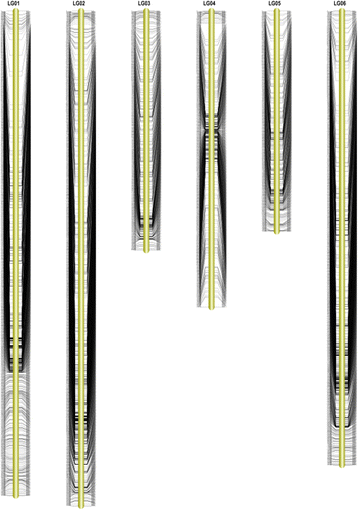Construction of a high-density genetic map and the X/Y sex-determining gene mapping in spinach based on large-scale markers developed by specific-locus amplified fragment sequencing (SLAF-seq)
- PMID: 28376721
- PMCID: PMC5379770
- DOI: 10.1186/s12864-017-3659-9
Construction of a high-density genetic map and the X/Y sex-determining gene mapping in spinach based on large-scale markers developed by specific-locus amplified fragment sequencing (SLAF-seq)
Abstract
Background: Cultivated spinach (Spinacia oleracea L.) is one of the most widely cultivated types of leafy vegetable in the world, and it has a high nutritional value. Spinach is also an ideal plant for investigating the mechanism of sex determination because it is a dioecious species with separate male and female plants. Some reports on the sex labeling and localization of spinach in the study of molecular markers have surfaced. However, there have only been two reports completed on the genetic map of spinach. The lack of rich and reliable molecular markers and the shortage of high-density linkage maps are important constraints in spinach research work. In this study, a high-density genetic map of spinach based on the Specific-locus Amplified Fragment Sequencing (SLAF-seq) technique was constructed; the sex-determining gene was also finely mapped.
Results: Through bio-information analysis, 50.75 Gb of data in total was obtained, including 207.58 million paired-end reads. Finally, 145,456 high-quality SLAF markers were obtained, with 27,800 polymorphic markers and 4080 SLAF markers were finally mapped onto the genetic map after linkage analysis. The map spanned 1,125.97 cM with an average distance of 0.31 cM between the adjacent marker loci. It was divided into 6 linkage groups corresponding to the number of spinach chromosomes. Besides, the combination of Bulked Segregation Analysis (BSA) with SLAF-seq technology(super-BSA) was employed to generate the linkage markers with the sex-determining gene. Combined with the high-density genetic map of spinach, the sex-determining gene X/Y was located at the position of the linkage group (LG) 4 (66.98 cM-69.72 cM and 75.48 cM-92.96 cM), which may be the ideal region for the sex-determining gene.
Conclusions: A high-density genetic map of spinach based on the SLAF-seq technique was constructed with a backcross (BC1) population (which is the highest density genetic map of spinach reported at present). At the same time, the sex-determining gene X/Y was mapped to LG4 with super-BSA. This map will offer a suitable basis for further study of spinach, such as gene mapping, map-based cloning of Specific genes, quantitative trait locus (QTL) mapping and marker-assisted selection (MAS). It will also provide an efficient reference for studies on the mechanism of sex determination in other dioecious plants.
Keywords: Genetic map; SLAF-seq; Sex-determining gene; Spinacia oleracea L.
Figures



Similar articles
-
High-density genetic map construction and QTLs identification for plant height in white jute (Corchorus capsularis L.) using specific locus amplified fragment (SLAF) sequencing.BMC Genomics. 2017 May 8;18(1):355. doi: 10.1186/s12864-017-3712-8. BMC Genomics. 2017. PMID: 28482802 Free PMC article.
-
Construction of a high-density genetic map and mapping of a sex-linked locus for the brown alga Undaria pinnatifida (Phaeophyceae) based on large scale marker development by specific length amplified fragment (SLAF) sequencing.BMC Genomics. 2015 Nov 5;16:902. doi: 10.1186/s12864-015-2184-y. BMC Genomics. 2015. PMID: 26541547 Free PMC article.
-
Construction of a high-density genetic map using specific-locus amplified fragments in sorghum.BMC Genomics. 2017 Jan 7;18(1):51. doi: 10.1186/s12864-016-3430-7. BMC Genomics. 2017. PMID: 28061813 Free PMC article.
-
A comprehensive map of the porcine genome.Genome Res. 1996 May;6(5):371-91. doi: 10.1101/gr.6.5.371. Genome Res. 1996. PMID: 8743988 Review.
-
Construction of a genetic linkage map in man using restriction fragment length polymorphisms.Am J Hum Genet. 1980 May;32(3):314-31. Am J Hum Genet. 1980. PMID: 6247908 Free PMC article. Review.
Cited by
-
Quantitative Trait Locus Mapping and Identification of Candidate Genes Controlling Bolting in Spinach (Spinacia oleracea L.).Front Plant Sci. 2022 Mar 30;13:850810. doi: 10.3389/fpls.2022.850810. eCollection 2022. Front Plant Sci. 2022. PMID: 35432424 Free PMC article.
-
Identification of a quantitative trait loci (QTL) associated with ammonia tolerance in the Pacific white shrimp (Litopenaeus vannamei).BMC Genomics. 2020 Dec 2;21(1):857. doi: 10.1186/s12864-020-07254-x. BMC Genomics. 2020. PMID: 33267780 Free PMC article.
-
Identification of Sex Differentiation-Related microRNAs in Spinach Female and Male Flower.Int J Mol Sci. 2022 Apr 7;23(8):4090. doi: 10.3390/ijms23084090. Int J Mol Sci. 2022. PMID: 35456907 Free PMC article.
-
Construction of a High-Density Genetic Map and Analysis of Seed-Related Traits Using Specific Length Amplified Fragment Sequencing for Cucurbita maxima.Front Plant Sci. 2020 Feb 21;10:1782. doi: 10.3389/fpls.2019.01782. eCollection 2019. Front Plant Sci. 2020. PMID: 32153597 Free PMC article.
-
High resolution mapping and candidate gene identification of downy mildew race 16 resistance in spinach.BMC Genomics. 2021 Jun 26;22(1):478. doi: 10.1186/s12864-021-07788-8. BMC Genomics. 2021. PMID: 34174825 Free PMC article.
References
-
- Khattak JZK, Torp AM, Andersen SB. A genetic linkage map of Spinacia oleracea and localization of a sex determination locus. Euphytica. 2006;148(3):311–318. doi: 10.1007/s10681-005-9031-1. - DOI
-
- Bemis W, Wilson G. A new hypothesis explaining the genetics of sex determination in Spinacia oleracea L. J Hered. 1953;44(3):91–95. doi: 10.1093/oxfordjournals.jhered.a106370. - DOI
-
- Ellis J, Janick J. The chromosomes of Spinacia oleracea. Am J Bot. 1960;210–214.
Publication types
MeSH terms
Substances
LinkOut - more resources
Full Text Sources
Other Literature Sources

